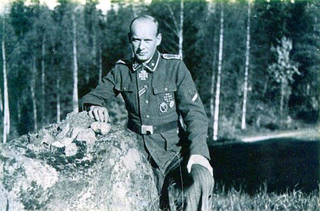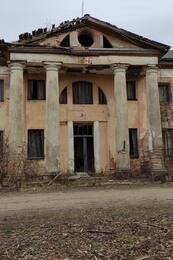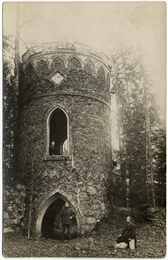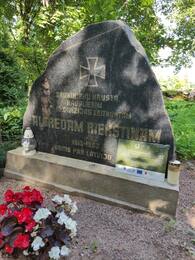Alfred Riekstins - Knight of the Knight's Cross
At the beginning of 1945, fierce battles were still taking place in the Courland fortress, where Latvians were fighting in the ranks of the German army. One of them was Alfrēds Riekstiņš in the 19th division. For his bravery, Riekstiņš was awarded the Knight's Cross and presented it at the Remte Castle. Shortly before the capitulation, he became a lieutenant.
It is mid-March 1945. Courland has been battered by shells for almost half a year. Thousands and thousands have fallen in five major battles. The great epicenter of the war has shifted to the outskirts of Berlin. The outcome of the war is clear to both sides. Only a few days, weeks, at worst, a few months remain, but the fortress of Courland still holds out. The Soviet high command does not spare its own - it sends more and more new groups of warriors to their deaths in senseless battles. Legionnaires defend every Latvian farmstead, hillock and birch grove.
In mid-March, everything indicates that the defenders of Courland will have to accept another major battle - the sixth, as it later turns out - the last. This time, the enemy is planning it on the outskirts of Saldus on the Remte side. How important it is for the Russians is shown by the fact that Marshals Vasilevsky, Chistyakov, the commander of the Baltic Fleet Yerjomenko and the representative of the General Staff Frolov arrive in Courland. On March 17, the Red Army breaks the front line in a rapid attack from the Pilsblīdene side near the "Ķīpi" houses and gains the Saldus-Kandava road, opening an excellent opportunity for Russian tanks to break into Courland. As usual, to eliminate such risky breaches, the command sends Major Laumanis' shock battalion. This time too, the major receives a similar order - at 7 p.m., after well-adjusted artillery fire, to regain the previous positions and eliminate the breach. It seems that there is something special - how few men of the Laumanis battalion rose up in such counterattacks, liberating more than one Latvian farmstead. However, this battle has gone down in the history of the battles in Kurzeme as the most unusual. Every military historian describes it in his memoirs and studies of the 19th Division's battle path, because the outcome of this battle, no matter how incredible it may be, was determined by the resourcefulness, courage, selflessness and recklessness of one man. Major Laumanis sends corporal Alfred Riekstins of the first company with eleven men as a scout. He knows what to send - Riekstins is an experienced warrior, having walked the 19th Division's battle path from Leningrad to his native Kurzeme without a single scratch. Recently, in the battles near "Rumba", the shock troops of their platoon destroyed seven dug-in Russian tanks with tank guns and liberated the houses of "Gibeļi".
Laumanis gives a combat mission - to observe the "Kīpi" houses from the nearby high ground at the Saldus-Pilsblīdene intersection and later adjust the artillery fire. They set up a telephone with the headquarters. Riekstiņš sees three Russian tanks, anti-tank guns and heavy machine guns positioned in the yard of the house in the distance - their owners feel safe, moving without any caution, as if a whole regiment of their own were ahead of them, who had gone in the direction of the Laumanis battalion. Alfred decided on a bold step - not to wait for the artillery fire on the "Kīpi" houses at 7 p.m., but to take them on his own. He knows - surprise and audacity have helped more than once in decisive moments. It turns out that some men - Brauns, Cilpiņš, Danbergs - know how to handle Russian heavy weapons. Along the forest edge, the men sneak into the yard, then a sudden attack, bloody, brutal close combat. Now the tank barrels are turned in the opposite direction, and this time they open fire on their own. The Russians flee in confusion and panic. The signalmen extend the telephone from the highlands to "Kīpā" and report that there is no need to direct artillery fire at "Kīpā" - their own people are there. The commander of the 19th division is confused - there is no need to fire artillery at "Kīpā", how did their own people appear there, if until recently the Russians were in charge there? Gradually everything becomes clear. The resourcefulness and courage of one man decided the outcome of a battle, saving the lives of many soldiers, at the same time, as if slamming the gate to the enemy's further invasion of Courland.
For his daring operation, Alfred Riekstins was awarded the Knight's Cross, making him one of twelve Latvians to receive the highest German officer award. The cross was presented to him on April 5 at Remte Castle. Later, the Germans discovered that ordinary soldiers were not awarded the Knight's Order and sent Riekstins to officer courses. Shortly before the capitulation, he became a lieutenant.
The German press also appreciated Riekstins' heroism. The newspaper "Tēvija" wrote: "In order for a Latvian corporal to enter the ranks of Knights, he had to do something extremely unusual and unimaginable. Riekstins eliminated the enemy's breakthrough and fiercely defended himself. He preserved the position of the entire division's wing." This, it seems, was the only case in the history of the German war when an officer's award was received by a corporal. It is interesting to note that this was also the last Knight's Cross awarded in the Courland fortress. Lieutenant Freimanis, who was nominated for the Knight's Cross at the end of April, no longer received it - the Germans had run out of supplies.
https://www.vilki.lv/FilmuLapa/alfreds-riekstins.html
https://www.tracesofwar.com/persons/68083/Riekstins-Alfreds.htm
Related timeline
Related objects
Pilsblidene Manor
The manor house was built in the classical style in the 1920s of the 19th century. After the land reform, the manor complex was rented out to private individuals, but from 1932 it passed to the Ministry of People's Welfare.
6. During the fierce battles of the Great Battle of Courland it was used both as a support post and as an infirmary.
On 17 March 1945, the last attempt of the Red Army to attack Courland began. Units of the German 24th Infantry Division defended themselves in the vicinity of the Pilsblidene Manor complex. On 18 March 1945, the manor house was attacked from the south by the 121st Rifle Regiment of the Latvian Rifle Division of the 43rd Guards, which was unsuccessful. The 1st Battalion of the 300th Rifle Regiment of the 7th Estonian Rifle Division attacked from the west, and at the end of the day the 35th Tank Brigade of the 3rd Guards Mechanised Corps joined the 1st Battalion of the 917th Rifle Regiment of the 249th Estonian Rifle Division on the Blīdene-Remte road.
On the night of 19 March, the 43rd Grenadier Regiment of the 19th Latvian SS Grenadier Division arrived in the vicinity of Blīdene Station and counter-attacked to retake the Pilsblīdene Manor residential building. However, as a result of a night tank attack, Estonian and Latvian units of the Red Army gained a foothold at the station.
In 1959, a fire broke out in the castle. From 1961 to 1986, a retirement home operated in the residential building. In 1986, the castle was again destroyed by fire. Since then, the castle has stood empty and ruined.
A 24-hectare park surrounds the manor house, which is now overgrown. The park has about 37 plantations of non-native species of trees and shrubs and is under state protection. The park is unmaintained and the surroundings are overgrown.
Remte manor house and park
Remte Manor Castle (German: Remten) is a manor house located in Remte. The buildings and the park of Remte Manor are national monuments. The manor house houses the Remte Primary School. Remte Manor Palace was built in 1800 in the Berlin Classicist style for the then owner of the manor, Count Karl Medem.
At the end of World War II, the 19th Division of the Latvian Legion of the German Army Group was stationed in Remte Manor and its surroundings.
Memorial Stone to Defenders of the Kurzeme Fortification
Located in Tukums region, on the side of the A9 highway, 500 m from the turnoff to Lesteni in the direction of Riga.
The memorial was established in 1991 near the Rumbu houses, which were the scene of active hostilities. It is a tribute to the defenders of the “Courland Fortress” who fought against the Red Army in World War II. The battles were significant because they temporarily halted the Red Army’s complete occupation of Latvia. Approximately 300,000 Latvians emigrated to escape the crimes committed against civilians by the Soviet regime.
At the end of World War II, a peculiar situation had developed in the territory of Latvia. German army forces were located in Courland, which the Red Army tried to eliminate or prevent from being involved in battles in East Prussia or around Berlin. “Courland Fortress” is the most common term used to describe the hostilities in Courland from 1944 to 1945. “The Battle of Courland” was the German army’s fight to repel the Red Army’s massive attacks. The Courland Fortress ceased to exist shortly after Germany’s capitulation.
Today, you can visit the memorial and resting place, which was popular among Latvian legionnaires since the restoration of Latvia's independence.









